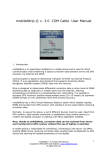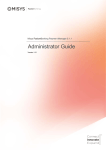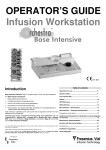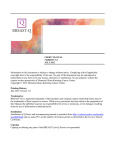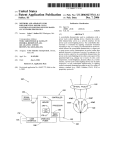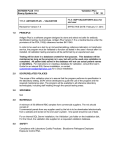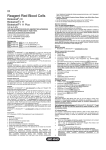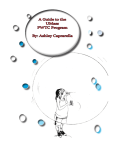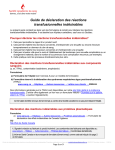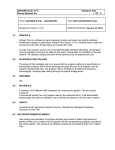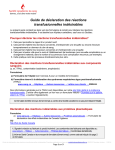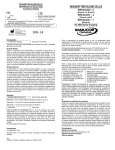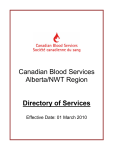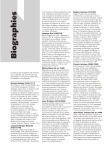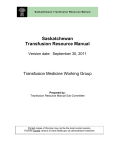Download reagents/ methods in use by alqep transfusion medicine participants
Transcript
REAGENTS/ METHODS IN USE BY ALQEP TRANSFUSION MEDICINE PARTICIPANTS An Educational Supplement prepared by ALQEP – October 2005 Alberta Laboratory Quality Enhancement Program The Transfusion Medicine (TM) Program of the Alberta Laboratory Quality Enhancement Program (ALQEP) provides mandated transfusion medicine proficiency testing for all laboratories performing TM test procedures in Alberta, British Columbia, Manitoba and Saskatchewan. As well, a number of laboratories in the Northwest Territories, Ontario and the Yukon Territory voluntarily participate in the program. Transfusion Medicine Profiles The ALQEP TM Program requests that participants complete a detailed profile upon registration. The profile is stored electronically by ALQEP and a copy is distributed to participants biannually with a request to enter and submit any changes that have occurred in the laboratory test methods or reagents. The last profile update request occurred in the fall of 2004. Data from the profiles on file at ALQEP has been tabulated and is presented in this paper. Any additional changes to the profiles submitted by participants since the 2004 update have been incorporated. Participant Demographics ALQEP Transfusion Medicine Participants Province Alberta British Columbia Manitoba Ontario Saskatchewan Northwest Territories Yukon Territory Total Level A* 11 16 2 1 4 0 0 34 Level B** 21 55 6 0 30 3 1 116 Total 32 71 8 1 34 3 1 150 *Level A facilities: facilities that perform ABO & Rh(D) typing, antibody screen, crossmatch (if performed at facility) and complex serologic investigation including the routine availability of at least 22 in-date panel cells, antigen typing, as required, and specialized investigation techniques **Level B facilities: facilities that perform ABO & Rh(D) typing, antibody screen, and crossmatch (if performed at facility); may perform basic serologic investigation including the routine availability of less than 22 in-date panel cells and possible antigen typing © Copyright 2005 College of Physicians and Surgeons of Alberta REAGENTS/ METHODS IN USE BY ALQEP TRANSFUSION MEDICINE PARTICIPANTS Participant Profiles Received: # (% of total participants) Province Alberta British Columbia Manitoba Ontario Saskatchewan Northwest Territories Yukon Total Level A 11 (100) 13 (81) 2 (100) 1 (100) 4 (100) na na 31 (91) Level B 21 (100) 50 (91) 6 (100) na 30 (100) 3 (100) 1 (100) 111 (96) Total 32 (100) 63 (89) 8 (100) 1 (100) 34 (100) 3 (100) 1 (100) 142 (95) Abbreviations The following abbreviations are used in the paper. Ab scr AIDAT Alb Alb 37 ALQEP Comm DAT DBL Gel auto Gel man IAT IS LIDAT LIS Macro Micro Min Mono Neg PEG PIDAT Poly RT S&T Sal Sal 37 SIDAT SP auto SP man TM Page 2 of 14 antibody screen albumin indirect antiglobulin test albumin albumin 37°C Alberta Laboratory Quality Enhancement Program commercial Rh control reagent direct antiglobulin test Dominion Biologicals Limited gel technology – automated procedure gel technology – manual procedure indirect antiglobulin test immediate spin low ionic strength saline (LISS) indirect antiglobulin test laboratory information system macroscopic microscopic minutes monoclonal negative polyethylene glycol polyethylene glycol indirect antiglobulin test polyclonal room temperature slide and tube saline saline 37°C saline indirect antiglobulin test solid phase technology – automated procedure solid phase technology – manual procedure Transfusion Medicine Alberta Laboratory Quality Enhancement Program © Copyright 2005 College of Physicians and Surgeons of Alberta CPSA: October 2005 REAGENTS/ METHODS IN USE BY ALQEP TRANSFUSION MEDICINE PARTICIPANTS ABO Typing 93% of respondents perform ABO typing by a saline tube method with the majority of these reading after immediate spin. 7% use gel technology for ABO typing. 13% of the laboratories using a tube method indicated that they include a room temperature incubation prior to reading the ABO forward typing and 16% read the reverse typing after RT incubation. 97% of respondents indicate that they utilize monoclonal reagents for ABO typing and 3% state they use monoclonal/polyclonal blend reagents. 36% of responding laboratories routinely include anti-A,B as part of the ABO typing. While only 10% of Level A facilities include this test with all ABO typings, 43% of Level B laboratories do so. 4% of facilities use anti-A,B for group O samples only, 13% use the reagent for donor ABO confirmation testing and 17% utilize the reagent under other special circumstances. 4% of respondents routinely include A2 cells with the ABO reverse typing, 10% include O cells and 13% perform an auto control in conjunction with the ABO typing. ABO Forward Typing: # (% of respondents) Method Level A Level B Total IS 26 (84) 87 (79) 113 (80) RT 3 (10) 16 (15) 19 (13) Gel man 1 (3) 7 (6) 8 (6) Gel auto 1 (3) 0 1 (1) Total 31 110 141 ABO Forward Typing: # (% of respondents) Reagent Type Level A Level B Total Mono 31 (100) 104 (96) 135 (97) Mono/Poly 0 4 (4) 4 (3) Total 31 108 139 ABO Forward Typing: # (% of respondents) Reagent Source Level A Level B Total DBL 23 (74) 83 (75) 106 (75) Immucor 0 3 (3) 3 (2) Ortho 8 (26) 24 (22) 32 (23) Total 31 110 141 ABO Forward Typing – Use of Anti-A,B: # (% of respondents) Criteria Level A Level B Total Always 3 (10) 48 (43) 51 (36) Group O 0 6 (5) 6 (4) Donors 13 (42) 5 (5) 18 (13) Babies 5 (16) 6 (5) 11 (8) Discrepancies 4 (13) 4 (4) 8 (6) Other 1 (3) 3 (3) 4 (3) ABO Reverse Typing: # (% of respondents) Method Level A Level B Total Page 3 of 14 IS 26 (84) 81 (76) 107 (78) RT 3 (10) 19 (18) 22 (16) Gel Man 1 (3) 7 (7) 8 (6) Gel Auto 1 (3) 0 1 (1) Alberta Laboratory Quality Enhancement Program © Copyright 2005 College of Physicians and Surgeons of Alberta Total 31 107 138 CPSA: October 2005 REAGENTS/ METHODS IN USE BY ALQEP TRANSFUSION MEDICINE PARTICIPANTS ABO Reverse Typing: # (% of respondents) Reagent Source Level A Level B Total DBL 20 (65) 50 (48) 70 (51) Gamma 0 2 (2) 2 (1) Immucor 5 (16) 15 (14) 20 (15) Ortho 6 (19) 38 (36) 44 (32) Total 31 105 136 ABO Reverse Typing – Additional Cells: # (% of respondents) Cells used Level A Level B Total A2 3 (10) 2 (2) 5 (4) O 3 (10) 11 (10) 14 (10) Auto 5 (16) 13 (12) 18 (13) Rh(D) Typing 80% of respondents perform Rh(D) typing by a saline tube immediate spin method and 7% use gel technology. 9% of respondents indicate that they include a room temperature incubation prior to reading the D typing and 5% of responses indicate methods that are not consistent with accepted routine D typing practice (i.e., sal 37, alb 37, SIDAT). 60% of respondents indicate that they utilize monoclonal IgM/IgG reagents for D typing, 23% use monoclonal IgM reagents and 14% state that they use monoclonal/polyclonal blend reagents. Slide and tube reagents are listed by 3%. 60% of responding facilities include an Rh control in conjunction with all D typing and 25% perform a control on all type AB or AB D-positive samples. 2% perform an Rh control only with weak D testing, 1% only on first testing and 11% of respondents state that they never perform an Rh control. Of those laboratories performing an Rh control, 53% use a commercially supplied reagent, 2% use a gel control, 4% use 22% albumin, 11% use 6–8% albumin and 24% use autologous serum or plasma. 6% use other reagents. Rh(D) Typing: # (% of respondents) Method Level A Level B Total IS 28 (90) 84 (77) 112 (80) RT 1 (3) 11 (10) 12 (9) Sal 37 0 4 (4) 4 (3) Alb 37 0 1 (1) 1 (1) Gel man 1 (3) 7 (6) 8 (6) Gel auto 1 (3) 0 1 (1) SIDAT 0 2 (2) 2(1) Total 31 109 140 Rh(D) Typing: # (% of respondents) Reagent type Level A Level B Total Page 4 of 14 Mono IgM 6 (19) 26 (24) 32 (23) Mono IgM/IgG 21 (68) 63 (58) 84 (60) Mono / poly 2 (6) 18 (17) 20 (14) S&T 2 (6) 2 (2) 4 (3) Alberta Laboratory Quality Enhancement Program © Copyright 2005 College of Physicians and Surgeons of Alberta Total 31 109 140 CPSA: October 2005 REAGENTS/ METHODS IN USE BY ALQEP TRANSFUSION MEDICINE PARTICIPANTS Rh(D) Typing: # (% of respondents) Reagent source Level A Level B Total Ortho 7 (23) 27 (25) 34 (24) DBL 21 (68) 73 (67) 94 (67) Gamma 1 (3) 1 (1) 2 (1) Immucor 2 (6) 8 (7) 10 (7) Total 31 109 140 Rh Control: # (% of respondents) Criteria Level A Level B Total Never 0 16 (15) 16 (11) All 15 (48) 69 (63) 84 (60) Group AB 10 (32) 17 (16) 27 (19) AB Rh+ 5 (16) 4 (4) 9 (6) Weak D 0 3 (3) 3 (2) Ist testing 1 (3) 0 1 (1) Total 31 109 140 Rh Control: # (% of respondent using an Rh control) Reagent type Level A Level B Total Comm 12 (39) 54 (58) 66 (53) 22% Alb 2 (6) 3 (3) 5 (4) 6-8% Alb 5 (16) 9 (10) 14 (11) 5% Alb 1 (3) 2 (2) 3 (2) 3% Alb 1 (3) 0 1 (1) Alb Auto 0 1 (1) 1 (1) 7 (23) 23 (25) 30 (24) Iner t AB 1 (3) 0 1 (1) Sal Gel Total 1 (3) 0 1 (1) 1 (3) 1 (1) 2 (2) 31 93 124 Confirmation of Patient ABO and Rh Typings 63% of respondents indicate that they perform confirmatory ABO and Rh testing on patient samples, 2% perform ABO confirmation only and 2% perform Rh confirmation only. Of those performing confirmation, 72% confirm the typing on all samples and 28% perform the testing if there is no historical typing on file. Confirmation Performed: # (% of respondents) Level A Level B Total ABO & Rh 21 (68) 69 (62) 90 (63) ABO Only 0 3 (3) 3 (2) Rh only 0 3 (3) 3 (2) Total respondents 31 111 142 ABO & Rh Confirmation: # (% of respondents performing confirmation) Criteria Level A Level B Total Page 5 of 14 Always 8 (38) 60 (82) 68 (72) No historical group 13 (62) 13 (18) 26 (28) Alberta Laboratory Quality Enhancement Program © Copyright 2005 College of Physicians and Surgeons of Alberta CPSA: October 2005 REAGENTS/ METHODS IN USE BY ALQEP TRANSFUSION MEDICINE PARTICIPANTS Antibody Screening A wide variety of antibody screening protocols are followed by participants. The majority of facilities utilize the PEG indirect antiglobulin test (37%) or gel technology (29%). 79% perform a 3 cell screen and 21% use 2 cells only. Of those participants performing a tube test method, 100% read the test after indirect antiglobulin test with 68% performing a macroscopic reading and 74% a microscopic reading. 66% read the test after immediate spin or room temperature incubation, and 48% read after 37° C incubation. Incubation times for the antibody screen vary. 56% of Level B participants using SIDAT method incubate the test for only 15minutes, which may not represent best practice (see Discussion). 52% of respondents include an auto control with the antibody screen and 25% routinely perform a DAT in conjunction with an antibody screen. 62% of facilities utilize an antiglobulin sera that contains anti-IgG only whereas 38% use a polyspecific reagent. Antibody Screening: # (% of respondents) Sample Used Level A Level B Total Serum 2 (6) 35 (32) 37 (26) Plasma 22 (71) 53 (48) 75 (53) Either 7 (23) 22 (20) 29 (21) Total 31 110 141 Antibody Screening: # (% of respondents) Method SIDAT AIDAT LIDAT PIDAT Level A Level B Total 0 18 (16) 18 (13) 0 6 (5) 6 (4) 4 (13) 13 (12) 17 (12) 12 (39) 41 (37) 53 (37) Gel man 10 (32) 29 (26) 39 (27) Gel auto 2 (6) 1 (1) 3 (2) SP man 3 (10) 1 (1) 4 (3) SP auto 0 2 (2) 2 (1) Total 31 111 142 Antibody Screening: # (% of respondents) # of Screening Cells Level A Level B Total 2 11 (35) 19 (17) 30 (21) 3 20 (65) 91 (83) 111 (79) Total 31 110 141 Gamma 0 1 (1) 1 (1) Immucor 6 (19) 14 (14) 20 (15) Antibody Screening: # (% of respondents) Screening Cells - Source Level A Level B Total Page 6 of 14 DBL 11 (35) 41 (40) 52 (39) Alberta Laboratory Quality Enhancement Program © Copyright 2005 College of Physicians and Surgeons of Alberta Ortho 14 (45) 47 (46) 61 (46) Total 31 103 134 CPSA: October 2005 REAGENTS/ METHODS IN USE BY ALQEP TRANSFUSION MEDICINE PARTICIPANTS Antibody Screening – Tube methods: # (% of respondents) Readings at: Level A Level B Total IS 5 (31) 50 (64) 55 (59) RT 0 7 (9) 7 (7) 37 2 (13) 43 (55) 45 (48) IAT Macro 11 (69) 53 (68) 64 (68) IAT Micro 7 (44) 63 (81) 70 (74) Antibody Screening – Tube methods: # (% of respondents) IAT Washing Level A Level B Total Cell washer 16 (100) 37 (49) 53 (58) Manual 0 38 (51) 38 (42) Antibody Screening – Tube methods: # (% of respondents) PIDAT: Incubation Time Level A Level B Total 10 min 7 (58) 27 (66) 34 (64) 15 min 5 (42) 14 (34) 19 (36) Antibody Screening – Tube methods: # (% of respondents) LIDAT: Incubation Time Level A Level B Total 10 min 3 (75) 4 (31) 7 (41) 15 min 1 (25) 7 (54) 8 (47) 20 min 0 1 (8) 1 (6) 30 min 0 1 (8) 1 (6) Antibody Screening – Tube methods: # (% of respondents) SIDAT: Incubation Time Level A Level B Total 15 min 0 10 (56) 10 (56) 30 min 0 7 (39) 7 (39) 40 min 0 1 (6) 1 (6) Antibody Screening – Tube methods: # (% of respondents) AIDAT: Incubation Time Level A Level B Total 15 min 0 2 (33) 2 (33) 30 min 0 4 (67) 4 (67) Antibody Screening: # (% of respondents) Controls included Level A Level B Total Page 7 of 14 Auto 8 (26) 66 (59) 74 (52) DAT 3 (10) 33 (30) 36 (25) Alberta Laboratory Quality Enhancement Program © Copyright 2005 College of Physicians and Surgeons of Alberta CPSA: October 2005 REAGENTS/ METHODS IN USE BY ALQEP TRANSFUSION MEDICINE PARTICIPANTS Antiglobulin Sera: # (% of respondents) Reagent Type Polyspecific – rabbit 2 (9) 15 (16) 17 (15) Level A Level B Total Polyspecific - mono 2 (9) 25 (27) 27 (23) IgG – rabbit 8 (36) 18 (19) 26 (23) IgG – mono 10 (45) 35 (38) 45 (39) Total Gamma 0 1 (1) 1 (1) Immucor 1 (4) 6 (6) 7 (6) Ortho 12 (46) 27 (28) 39 (32) Total 26 96 122 22 93 115 Antiglobulin Sera: # (% of respondents) Reagent Source Level A Level B Total DBL 13 (50) 62 (65) 75 (61) Antibody Identification The majority of respondents (65%) required antibody identification of each positive antibody screen, regardless of circumstances. However, a number of laboratories only require repeat antibody identification at defined intervals or if a change in antibody reactivity or patient history is noted. Repeat antibody identification on positive antibody screen: # (% of respondents) Frequency Each specimen Level A 14 (45) Level B Total 79 (71) 93 (65) 3 days 5 (16) 4 (4) 9 (6) 1 (3) Repeat every: 14 30 3 days days months 3 (10) 1 (3) 0 2 (2) 3 (2) 2 (2) 5 (4) 7 days 0 1 (1) 2 (2) 2 (1) 6 months 0 Change in reactivity If possibly stimulated 10 (32) 3 (10) 15 (14) 25 (18) 17 (15) 20 (14) 1 (1) 1 (1) Compatibility Testing The majority of respondents (85%) perform a serologic crossmatch, with 27% utilizing a saline immediate spin method. 15% of respondents routinely perform an electronic crossmatch, with 47% of Level A facilities choosing this method. Crossmatch: # (% of respondents) Method Level A Level B Total Page 8 of 14 Sal IS 14 (47) 24 (22) 38 (27) SIDAT 0 17 (15) 17 (12) AIDAT 0 6 (5) 6 (4) LIDAT 1 (3) 12 (11) 13 (9) PIDAT 0 27 (24) 27 (19) Gel man 1 (3) 18 (16) 19 (14) Alberta Laboratory Quality Enhancement Program © Copyright 2005 College of Physicians and Surgeons of Alberta Electronic 14 (47) 7 (6) 21 (15) Total 30 111 141 CPSA: October 2005 REAGENTS/ METHODS IN USE BY ALQEP TRANSFUSION MEDICINE PARTICIPANTS Confirmation of Donor ABO and Rh Typings 79% of respondents perform confirmatory ABO and D typing on all donor units received, 2% retype all type O units and 6% confirm O Rh negative units. Confirmation Performed: # (% of respondents) All units 26 (87) 85 (77) 111 (79) Level A Level B Total All type O 0 3 (3) 3 (2) All O Rh Neg 1 (3) 8 (7) 9 (6) Postnatal Testing 82% of respondents perform postnatal testing, with 26% of those testing all deliveries and 73% testing only cases where the mother’s Rh type is negative or unknown. Testing protocols vary widely among respondents. Postnatal Testing: # (% of respondents) Performed Level A Level B Total Yes 26 (84) 91 (82) 117 (82) No 5 (16) 20 (18) 25 (18) Total 31 111 142 Postnatal Testing: # (% of respondents performing postnatal testing) Criteria All deliveries Level A Level B Total 6 (23) 24 (26) 30 (26) Moms – Rh Neg or unknown 20 (77) 66 (73) 86 (73) Only on request 0 1 (1) 1 (1) Postnatal Testing: # (% of respondents performing postnatal testing) Tests performed Level A Level B Total Page 9 of 14 ABO/Rh – mom 14 (54) 55 (60) 69 (59) Rh – mom 1 (4) 2 (2) 3 (3) ABO/Rh – cord 24 (92) 87 (96) 111 (95) Rh – cord 1 (4) 4 (4) 5 (4) Ab scr - mom 14 (54) 40 (44) 54 (46) Alberta Laboratory Quality Enhancement Program © Copyright 2005 College of Physicians and Surgeons of Alberta DAT – cord 23 (88) 81 (89) 104 (89) Fetal cell screen / refer 22 (85) 45 (49) 67 (57) CPSA: October 2005 REAGENTS/ METHODS IN USE BY ALQEP TRANSFUSION MEDICINE PARTICIPANTS Information Systems 68% of respondents indicate that a LIS is in place in the laboratory. Only one Level A facility does not have a LIS whereas 40% of Level B facilities do not have this technology. 56% of respondents do not have a Transfusion Medicine Information system. Laboratory Information Systems: # (% of respondents) System CCD Cerner Eclipsis HealthVision Labview Mak Progesa Medisolution Meditech Northern Software RSA (Roses) SCC Soft Lab Sunquest / Misys Triple G In-house developed System source not identified None Total Level A 0 4 (13) 1 (3) 3 (10) 0 2 (6) 0 10 (32) 0 0 1 (3) 1 (3) 3 (10) 1 (3) 2 (6) 2 (6) 1 (3) 31 Level B 1 (1) 0 0 0 1 (1) 0 5 (5) 17 (15) 2 (2) 1 (1) 0 0 8 (7) 14 (13) 1 (1) 17 (15) 44 (40) 111 Total 1 (1) 4 (3) 1 (1) 3 (2) 1 (1) 2 (1) 5 (4) 27 (19) 2 (1) 1 (1) 1 (1) 1 (1) 11 (8) 15 (11) 3 (2) 19 (13) 45 (32) 142 Transfusion Medicine Information Systems: # (% of respondents) System Part of LIS In-house developed Lifeline Hemocare None Total Page 10 of 14 Level A 26 (84) 1 (3) 1 (3) 2 (6) 1 (3) 31 Level B 31 (28) 1 (1) 0 0 79 (71) 111 Total 57 (40) 2 (1) 1 (1) 2 (1) 80 (56) 142 Alberta Laboratory Quality Enhancement Program © Copyright 2005 College of Physicians and Surgeons of Alberta CPSA: October 2005 REAGENTS/ METHODS IN USE BY ALQEP TRANSFUSION MEDICINE PARTICIPANTS Discussion ABO Typing Traditionally, anti-A,B was considered a necessary part of ABO forward typing as it was more effective than human anti-A or anti-B in detecting weakly expressed ABO antigens.1,2,3 However, the use of monoclonal antibodies for the production of anti-A and anti-B has eliminated the necessity for the routine use of anti-A,B. The inclusion of A2, O or autologous cells with an ABO typing may be useful in investigation of discrepant results but is considered to be of limited value in routine testing.3 Rh(D) Typing The majority of respondents utilize appropriate methods, reagents and controls for Rh(D) typing. However, the profile responses indicate that a small number of facilities are not following accepted D-typing practice or are confused about the D testing performed in their laboratory. Laboratories should determine the characteristics of the reagent in use and manufacturer’s instructions must be followed for all testing. The use of an appropriate Rh control is required to ensure that false positive reactions are not occurring due to immunoglobulin coating of red cells or serum factors that induce rouleaux.3 In the past, a manufacturer’s control was supplied with slide and tube reagents. However, the advent of monoclonal anti-D reagents has changed the required Rh typing practice. The diluents for these reagents may contain from 3 to 8% bovine serum albumin and they are regarded as low-protein anti-D. Therefore, the routine use of an Rh control is not required with monoclonal Rh(D) typing reagents.4,5,6 However, as red cells heavily coated with immunoglobulin may give unreliable results and spontaneous agglutination may occur in any saline-reactive test in the presence of cold autoagglutinins or rouleaux, a concurrent control must be performed for red cell specimens that demonstrate positive reactions in all ABO forward grouping and Rh typing tests (i.e., group AB, D-positive).3.7 The recommended control reagent is a manufacturer’s control, autologous serum, or 6 – 8% bovine serum albumin.3 Confirmation of Patient ABO and Rh(D) Typings Confirmation of patient ABO typing is only required by standards8,9 if an electronic (computer assisted) crossmatch is performed. Although only 15% of facilities utilize an electronic crossmatch, 65% of laboratories choose to perform ABO confirmation on patient samples. 65% of facilities also confirm the patient D type. Antibody Screening Transfusion medicine standards8,9 require that antibody screening shall include a 37°C incubation followed by an indirect antiglobulin procedure that has been shown to have good sensitivity for the detection of clinically significant antibodies or an alternative test method with appropriate documentation of sensitivity. Although all facilities use test methods that are acceptable, a number of Level B laboratories incubate SIDAT antibody screens for only 15 minutes. It is generally recommended that 30 to 60 minute incubation is necessary for saline based tests3 and these facilities should consider increasing the incubation time or changing to a method that includes an enhancement media. Although it has been shown that the omission of reading of antibody screens at immediate spin phase, after 37°C incubation and microscopically does not result in significant patient risk,1,3,10,11,12 a number of laboratories, most notably Level B facilities, continue these practices. As well, 52% of participants include an auto control with antibody screening and 25% routinely perform a direct antiglobulin test with pretransfusion testing. These tests are believed to be of limited clinical value.3,13,14 Page 11 of 14 Alberta Laboratory Quality Enhancement Program © Copyright 2005 College of Physicians and Surgeons of Alberta CPSA: October 2005 REAGENTS/ METHODS IN USE BY ALQEP TRANSFUSION MEDICINE PARTICIPANTS Standards8,9 state that the use of an antiglobulin reagent that contains only anti-IgG is acceptable and the use of a polyspecific reagent containing anti-complement has been shown to be unnecessary in pretransfusion testing.15 While the use of a polyspecific reagent by a number of laboratories does not pose a risk to patient safety, it may result in unnecessary antibody investigation. Antibody Investigation Although the majority of participants continue to perform antibody identification on each sample with a positive antibody screen, a significant number of laboratories have streamlined their processes to include re-identification of known antibodies under defined criteria. While re-identification of known antibodies rarely serves a significant purpose, methods of testing must detect any additional clinically significant antibodies.3 Compatibility Testing Most Level A facilities perform compatibility testing between patient and donor by either immediate spin crossmatch (49%) or electronic crossmatch (47%). The majority of Level B (85%) continue to perform a serologic crossmatch with 44% performing an antiglobulin method. This may indicate that the resources required for serologic crossmatch in a high volume facility are significant and better directed to other activities whereas smaller laboratories do not possess the required technology or feel that the additional confidence derived from a serologic crossmatch is of benefit. Confirmation of Donor ABO and Rh Typings Canadian transfusion medicine standards8,9 only require that the transfusion service confirm the ABO type of donor red cells if a serologic crossmatch is not to be performed. AABB standards16 require ABO confirmation of all donor units and Rh confirmation of all Rh negative units. The majority of respondents have chosen to perform this testing. Postnatal testing There is a wide variation of testing protocols used by those laboratories performing postnatal testing with acceptable practice represented in most areas. However, only 57% of respondents state that they perform or order fetal bleed detection tests when indicated by the mother and cord Rh types. This test is required by standards8,9 and has significant impact on patient care. Laboratories should review their protocols to ensure that appropriate processes are in place. Information Systems While the majority (97%) of Level A facilities have a Laboratory Information System and a Transfusion Medicine Information System, a significant number of Level B laboratories (40% - LIS; 71% - TM information system) do not have access to these technologies. Page 12 of 14 Alberta Laboratory Quality Enhancement Program © Copyright 2005 College of Physicians and Surgeons of Alberta CPSA: October 2005 REAGENTS/ METHODS IN USE BY ALQEP TRANSFUSION MEDICINE PARTICIPANTS Conclusion The responses to the Transfusion Medicine profiles indicate that while laboratory practices may vary widely, the majority of participants have methods and reagents in place that allow for acceptable testing results. This represents appropriate patient care and safety. A small number of laboratories should review testing processes and procedures. The use of an appropriate Rh control test and acceptable antibody screen incubation times are necessary to ensure accurate test results. Although the inclusion of various other aspects of testing does not introduce any direct patient risk, the resources required to perform these tests, or to investigate discrepant findings, could be better directed to other processes that may benefit patient outcome. Also, the investigation of clinically insignificant discrepant results not only places additional strain on resources, but may delay transfusion. The ALQEP Transfusion Medicine Program distributes participant profiles for biannual revision and will report on any significant changes in laboratory practice following the next update. Page 13 of 14 Alberta Laboratory Quality Enhancement Program © Copyright 2005 College of Physicians and Surgeons of Alberta CPSA: October 2005 REAGENTS/ METHODS IN USE BY ALQEP TRANSFUSION MEDICINE PARTICIPANTS References 1. Judd WJ. Modern approaches to pretransfusion testing. Immunohematology 1999;15:41-52. 2. Moore BPL, Humphreys P, Lovett-Moseley CA. Serological and immunological methods. 7th ed. Toronto ON: Canadian Red Cross Society, 1972. 3. Brecher ME, ed. Technical manual. 14th ed. Bethesda MD: American Association of Blood Banks, 2002. 4. Gamma Biologicals; Houston TX. Package insert: anti-D (monoclonal/ polyclonal blend) Gamma-clone®, 1996. 5. Dominion Biologicals Limited; Dartmouth NS, Canada. Package insert: anti-D (monoclonal/polyclonal blend) NovacloneTM, 1996. 6. Gamma Biologicals; Houston TX. Package insert: anti-D (monoclonal blend) Gamma-clone® , 2000. 7. Padget BJ, Hannon JL. Discrepancies in Rh(D) typing of sensitized red blood cells using monoclonal/polyclonal anti-D reagents: case report and review. Immunohematology 2001;17:10-13. 8. Standards for hospital transfusion services. Version 1. Ottawa ON: Canadian Society for Transfusion Medicine, 2004. 9. Z902-04 Blood and blood components. Mississauga ON: Canadian Standards Association, 2004. 10. Issitt PD. Antibody screening: elimination of another piece of the test. Transfusion 1999:39:229-230. 11. Judd WJ, Steiner EA, Oberman HA, Nance SJ. Can the reading for serologic reactivity following 37ºC incubation be omitted? Transfusion 1992;32:304-308. 12. Judd WJ, Fullen DR, Steiner EA, Davenport RD, Knafl PC. Revisiting the issue: can the reading for serologic reactivity following 37ºC incubation be omitted? Transfusion 1999;39:295-299. 13. Judd WJ, Butch SH, Oberman HA, Steiner EA, Bauer RC. The evaluation of a positive direct AHG test in pretransfusion testing. Transfusion 1980;20:17-23. 14. Judd WJ, Barnes BA, Steiner EA, Oberman HA, Averill DB, Butch SH. The evaluation of a positive direct AHG test in pretransfusion testing revisited. Transfusion 1986;26:220-4. 15. Beck ML, Marsh WL. Complement and the antiglobulin test. Transfusion 1977;17:529. 16. Standards for blood banks and transfusion services. 23nd ed. Bethesda MD: AABB, 2005. Page 14 of 14 Alberta Laboratory Quality Enhancement Program © Copyright 2005 College of Physicians and Surgeons of Alberta CPSA: October 2005














